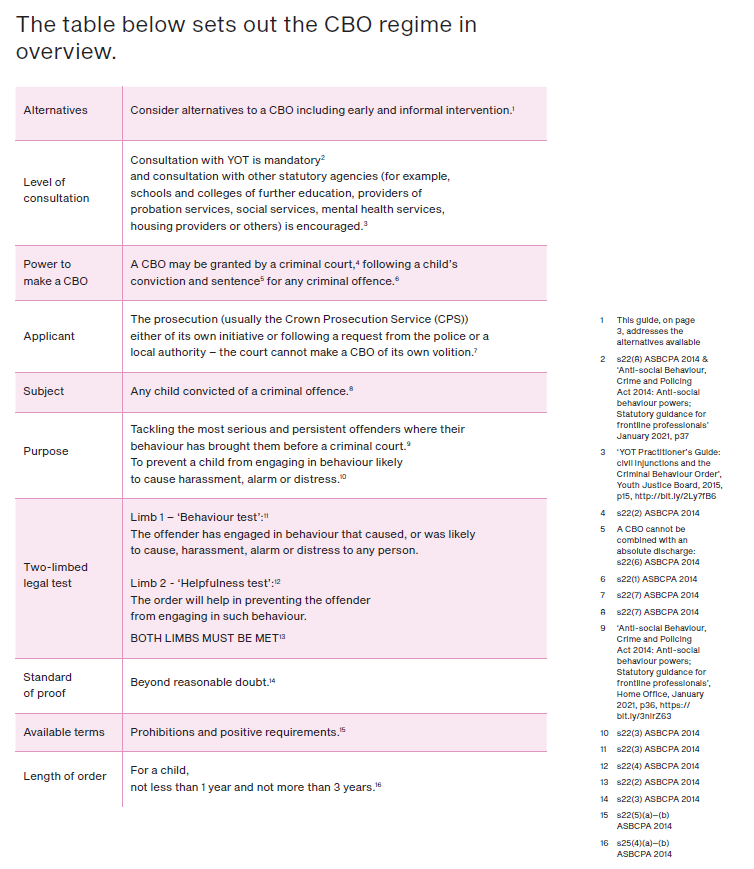Case study – A
On 14 March 2019 a 15 year old was sentenced for the offence of possession of a bladed article (a second offence) to a Youth Rehabilitation Order of 12 months with the following requirements: supervision; 30 hours’ reparation; Violence Reduction Programme; and an electronically monitored curfew for 2 months between 8pm and 7am.
A had previously been sentenced to a Referral Order of 9 months for one offence of possession of a bladed article and one offence of the possession of Class A drugs on 12th November 2018.
At A’s sentence hearing the prosecution indicated that they wished to apply for a CBO. The defence confirmed the application would be contested. The YOT, who were supervising A’s sentence, did not support the application.
The application proposed 5 conditions: a combination of prohibitions and positive requirements.
Prohibitions – not to:
- Remain in the immediate presence of any of the following persons in any Public Place in England and Wales: [named persons]
- Carry any knife or bladed article in any public place, even if the blade is less than three (3) inches.
- Be in possession of more than ONE (1) Mobile Phone handset in a public place.
- Be in possession of more than ONE (1) SIM card in a Public Place.
- Positive requirement:
A must remain inside an address agreed by Youth Offending Service and Court and present himself in person to any Police Officer in attendance between the hours of 1900 and 0600 for a period of NINETY (90) days.
The application relied on evidence from two police officers.
A defence skeleton argument was served in advance of the hearing, outlining the grounds of opposition to the application.
In summary, it was argued that the first limb of the test was not satisfied as there was no evidence that A had engaged in anti-social behaviour and any material that did exist was incapable of satisfying the court, to the criminal standard, that A had engaged in such behaviour.
- The prosecution evidence on which the prosecution sought to rely was not specific to A. The evidence given in the witness statements of the officers did not appear to contain any personal knowledge of A or any particulars of the incidents reported. One statement merely presented generic information collated from police records and the second made only general reference to the effect of knife crime.
For instance, one officer stated that A lived in an area frequented by a ‘gang’ engaged in drill music. There was no evidence of A being involved in this.
- A’s antecedent record did not establish either that A had been committing crimes in public or that members of the public were in any way exposed to them, such as to be caused harassment, alarm or distress.
For instance, in relation to A’s conviction for possession of a bladed article in November 2018 there was no evidence that A had been engaged in anti-social behaviour at the time he was stopped and searched. The knife that formed the basis of the charge was found in a hedge. It was not being brandished, it was not suggested that there were any civilian witnesses and members of the public were not present.
In relation to the second limb of the test, it was argued that the conditions failed to satisfy the helpfulness test and were neither tailored nor proportionate.
- Condition 1 referred to a list of people, several of whom attended the same educational establishment and YOT as A. They were not people with whom A had committed offences.
- Condition 2 prevented A from being able to use cutlery in a public place such as an educational establishment or restaurant. This had implications for his right to private life under Article 8 of the European Convention on Human Rights.
- A prohibition on A having only one SIM card and one mobile phone did not satisfy the helpfulness test, as A did not have any convictions for criminal conduct connected with the use of multiple SIM cards and phones, such as possession with intent to supply (PWITS).
- The proposal that A be subject to an electronically monitored curfew failed the helpfulness test. The sentencing court had already imposed an electronically monitored curfew designed to address the cause of A’s offending, following a recommendation by YOT, who were best placed to judge what conditions would be appropriate. In these circumstances the imposition of a more onerous curfew was clearly disproportionate.
Throughout, the defence reminded the court of its obligation to treat A’s welfare as paramount.
The application was refused.
